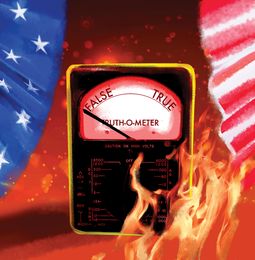The recent presidential debate between Joe Biden and Donald Trump was a sorry spectacle that ended with two old men being childish about their golf handicaps. But Biden had at least one bright moment when he deployed a rare word—malarkey—to describe the torrent of misinformation unleashed by Trump. Biden couldn’t quite keep up with that cascade as he was too busy waffling; fittingly, he stopped by at Waffle House on his way home after the debate.
I had to look up ‘malarkey’. An American invention from the 1920s, it has synonyms aplenty: balderdash, baloney, blah, poppycock…. You get the point. The sheer amount of malarkey during that debate was described by one news platform as a “tsunami of falsity”; not surprisingly, fact-checkers are now having a field day spotting, categorising, grading the falsehoods and issuing corrections. Fact-checking, once an in-house job assigned to juniors and interns, is today a fast-growing pillar of modern journalism offering sky-high growth. The raw material that fuels this profession seems unlimited: a never-ending supply of falsehood, fake news, half-truths and biased reporting. All easily and instantly propagated over the internet and social media.
Among the several establishments committed to fact-checking in the interests of transparency and truth is the The Washington Post; its column “The Fact Checker”, headed by senior editor Glenn Kessler, has been in the business for 15 years. An inaugural signatory to the code of the principles of the International Fact-Checking Network (yes, there is such a thing), it applies its “Pinocchio” test to distinguish fact from political fiction. One Pinocchio means a statement that is “mostly true” but with some “shading of the facts”; two Pinocchios imply significant omissions and exaggerations; three Pinocchios mean a claim is “mostly false” and four Pinocchios indicate a way-out whopper. An upside-down Pinocchio signifies a flip-flop and a broad red tick is the rarely awarded Gepetto Checkmark for the “truth, the whole truth and nothing but the truth.” If a claim repeatedly gets three or four Pinocchios, it becomes a Bottomless Pinocchio. The last category was introduced in 2018, when Trump was in full flow. Incidentally, The Washington Post recorded 30,573 untruths by Trump in his four-year term, averaging 21 falsehoods a day. A huge electronic board hanging over the Post’s lobby in Washington DC enabled you to check the daily score.
PolitiFact, a Pulitzer Prize winning website, is another fact-checking powerhouse, with a Truth-o-Meter replacing the Pinocchio. Completely ridiculous claims show up as Pants on Fire on the Truth-o-Meter; Trump’s claim that Biden had allowed millions of people illegally into the country from jails and mental institutions was adjudged a Pants on Fire claim. PolitiFact also runs a Flip-o-Meter to measure consistency in statements. A full flop on this meter is the equivalent of an upside-down Pinocchio. It isn’t just politicians who are under the scanner: PunditFact, a partner website, is constantly fact-checking talking heads. Snopes, another internet-based platform, calls itself the definitive source for “urban legends, folklore, myths, rumours, and misinformation”. They fact-checked Biden’s statement that 158 or 159 presidential historians had voted Trump as the worst president in American history; the claim was judged as true, though the number of survey participants was actually 154; the top spot went, no surprises, to Abraham Lincoln.
So young boys who once dreamt of becoming railway engine drivers when they grew up should now aim to be fact-checkers. The best and brightest should of course go west like the IITians of yore, to the shining city on the hill where nothing is but what is not. But chances are that soon we will have enough malarkey of our own and they can all come back to Bengaluru.
The writer is former ambassador to the US.


